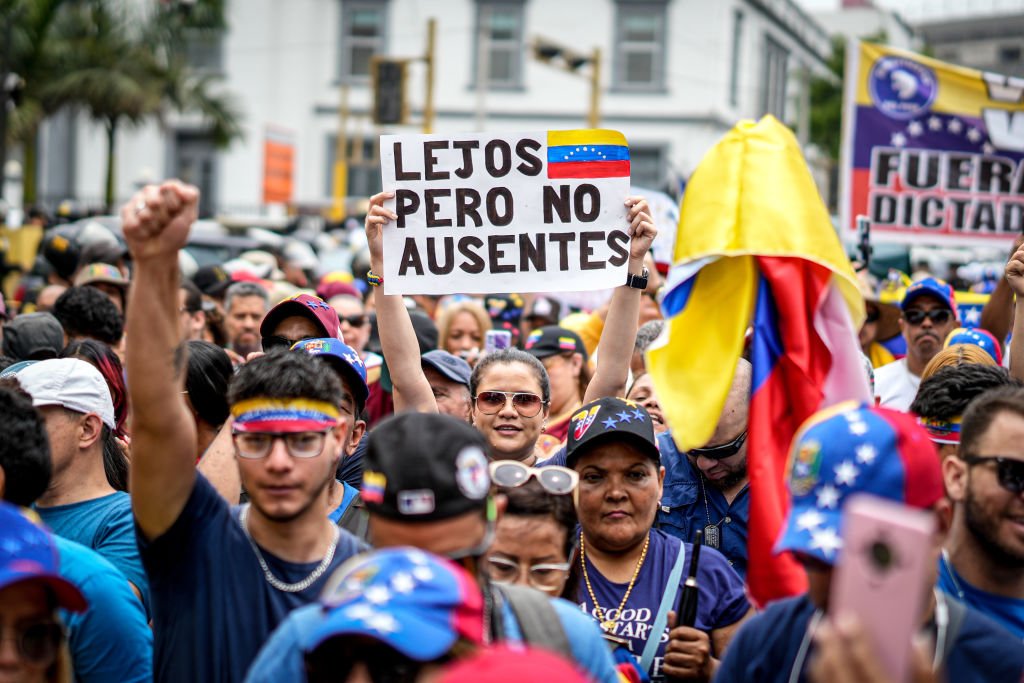Nearly 8 million Venezuelans have left their country since 2014, making it the largest migration crisis in Latin American history and the second-largest worldwide after Syria. This exodus has not only reshaped Venezuelan society but also transformed political and economic dynamics across the Americas.
More than half of Venezuelan migrants now live in Colombia (2.81 million) and Peru (1.66 million), a group of people that outnumbers Panama’s population. In the face of extraordinary hardship, Venezuelan migrants in Colombia and Peru are navigating their new realities with remarkable resilience.
Recent public opinion studies by the Center for Global Democracy (CGD) at Vanderbilt University show that large numbers of Venezuelan migrants in these countries lack formal employment, have difficulty making ends meet, struggle to access health services, and experience frequent discrimination. Still, many express optimism about their families’ futures in their host countries.
This contrast between adversity and hope offers a powerful lens for better understanding the complex and evolving dynamics of the Venezuelan diaspora, for whom the prospects of return are increasingly unlikely. Amid an ongoing economic crisis and the Maduro regime’s crackdown on dissent, it is probable that most Venezuelan migrants will stay in their host countries.
Shared economic struggles, diverging pressures
Between August and December 2024, CGD conducted surveys with Venezuelan migrants in key cities in Colombia and Peru, reaching 1,006 Venezuelans in Bogotá, Cúcuta, Medellín, and Ipiales in Colombia, as well as 1,074 Venezuelans across Lima, Trujillo, and Tumbes in Peru. To access the datasets, click here. These surveys, among the few large-scale research efforts focused on the Venezuelan diaspora, offer rare insights into how migrants are adjusting.
Because the Venezuelan diaspora is a hard-to-reach population, the samples cannot be considered fully representative of all Venezuelans in these countries, or of the diaspora as a whole. Still, the data offers a rich snapshot of migrant experiences in key urban areas.
Surveyed Venezuelans across Colombia and Peru face steep economic challenges. The vast majority report working in the informal sector, leaving most migrants without labor protections, benefits, or stable incomes. Nearly two-thirds of Venezuelans interviewed in each country report that their household income is insufficient to meet basic needs. Surveyed migrants also report limited access to public health services: 57% in Colombia and 61% in Peru say it is difficult to access care. This data underscores persistent barriers to integration and upward mobility in their new countries.
These shared vulnerabilities define the Venezuelan migrant experience, but there are notable differences between countries. More Venezuelans surveyed in Colombia report being unemployed (37%) and having difficulty in finding work (67%) than in Peru (25% and 51%, respectively). These gaps may reflect both differences in structural conditions and different stages of economic integration among migrants.
Xenophobia and discrimination
In addition to economic hardship, respondents report high levels of xenophobia. Discrimination affects migrants in both countries, but to different extents. Surveyed migrants in Peru report significantly higher discrimination levels, with nearly three-quarters (73%) stating they have experienced discrimination because of their nationality, compared to 58% in Colombia. Discrimination based on economic status and accent is also common: 38% of Venezuelans interviewed in Peru report discrimination due to socioeconomic class, and 37% due to how they speak, compared to 29% and 25%, respectively, in Colombia.
These patterns mirror broader political and media environments. While Colombia has formally embraced a welcoming policy by offering temporary protection status to nearly 2.5 million Venezuelans, economic pressures and xenophobia remain. In Peru, a more restrictive immigration policy, increasing deportations, and hostile narratives in the media have contributed to a more precarious environment.
Resilience and optimism
Despite significant challenges, 81% of Venezuelan migrants in Colombia and 77% in Peru believe a positive future is likely in their host countries. When examined more closely, differences become apparent: in Peru, 26% say it’s “very likely” and 51% say “somewhat likely,” whereas in Colombia, 45% say “very likely” and 36% say “somewhat likely.” Similarly, many report that they rarely feel like a stranger in Colombia (50%) or Peru (38%).
This optimism is reflected in migrants’ future migration plans. Venezuelans surveyed in Colombia appear to be more inclined to stay than those in Peru, despite reporting greater economic hardship. Nearly 89% of respondents in Colombia said it was “very likely” they would remain in the country over the next year, compared to 69% in Peru. And while many of those surveyed in both countries expressed a desire to return to Venezuela someday (55% in Peru, 43% in Colombia), a larger share in Colombia say they intend to stay permanently: 38%, compared to 29% in Peru.
Even though larger percentages of respondents in Colombia intend to stay, “step migration” toward the U.S. is also more common in Colombia. That is, among respondents planning to leave again, more Venezuelan migrants in Colombia than in Peru (53% vs. 38%) say they hope to move to the U.S. The elimination of Temporary Protected Status (TPS) for Venezuelans in the U.S., combined with the Trump administration’s broader immigration crackdown, has fueled uncertainty and fear among migrants. For many Venezuelans in Colombia, the U.S. may appear increasingly difficult to reach due to stricter policies, yet it remains a powerful symbol of opportunity and stability that continues to drive migration aspirations.
These patterns suggest that Venezuelan migrants in Colombia may be facing more structural push factors like unemployment and limited job opportunities, while those in Peru may be experiencing more intense social rejection. Both contexts complicate the Venezuelan diaspora’s possibilities of successful integration.
Despite differences in migration intentions across countries, large segments of Venezuelan migrants across Colombia and Peru express a willingness to stay, even with persistent barriers to both economic security and full societal acceptance. This points to a resilience that transcends material conditions and exists even without full inclusion in their host communities. For many, a sense of stability and hope is not solely tied to their current circumstances but is also rooted in the difficult decision to leave Venezuela, often under duress, in pursuit of safety, opportunity, and a better future for their families.
A diaspora that is here to stay
While many Venezuelan migrants hold on to the idea of returning home, the notion of doing so under safe or favorable circumstances is increasingly hypothetical. Venezuela’s July 2024 elections were widely condemned as undemocratic, and the Maduro government continues to crack down on dissent. Persecution of opposition figures and civil society actors ramped up further following the 2025 legislative elections, reinforcing a climate of repression.
Venezuela has endured one of the most severe economic crises in the Western Hemisphere’s history. About 80% of the population lives below the poverty line, with nearly 53% in extreme poverty, and living conditions remain harsh. Under a fragile recovery driven almost entirely by oil production-related activities, the country faces deeper structural vulnerabilities—namely, hyperinflation, fiscal imbalances, U.S. sanctions, and socioeconomic collapse—that continue to threaten its long-term stability. Human rights violations persist, and basic services are still severely limited. For many, there is little to return to in the foreseeable future.
These surveys suggest that large numbers of Venezuelans are settling in their host countries. They are doing this not because they no longer wish to return to their homeland, but because they are committed to building new lives where they can. How host countries and their communities choose to support, integrate, or exclude Venezuelan migrants will continue to shape not only individual experiences, but the social and political fabric of diaspora-receiving countries and the region.






